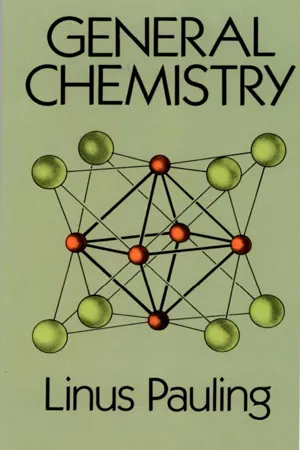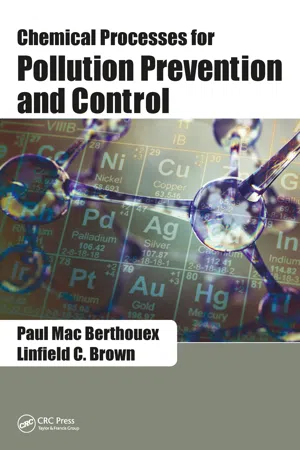Chemistry
Weak Acid and Base Equilibria
Weak acid and base equilibria refer to the dynamic balance between the undissociated molecules and their respective ions in a solution. In the case of weak acids, the equilibrium lies more towards the undissociated form, while for weak bases, it lies more towards the dissociated form. The equilibrium constant (Ka for weak acids, Kb for weak bases) quantifies the extent of dissociation.
Written by Perlego with AI-assistance
Related key terms
Related key terms
1 of 4
Related key terms
1 of 3
12 Key excerpts on "Weak Acid and Base Equilibria"
- eBook - ePub
- Patrick E. McMahon, Rosemary McMahon, Bohdan Khomtchouk(Authors)
- 2019(Publication Date)
- CRC Press(Publisher)
26 Acid/Base Equilibrium, pH, and BuffersThe general concepts of acids, bases, and acid/base reactions were described in Chapter 9 and Chapter 23 described techniques for solving acid/base equilibria. In this chapter, these skills are combined for a complete analysis of all reaction combinations of strong and weak acids and bases.I ACID AND BASE DISSOCIATION REACTIONS: ACID AND BASE STRENGTH Acid molecules react with water in an acid/base reaction with water molecules acting as the base; the result is acid dissociation in water or acid ionization. Note that the format showing the base role of water in the reaction indicates that H3 O+ is the conjugate acid of water as a base.Since H3 O+ (H2 O••—H+(aq) ) is considered to be identical to H+(aq) for this reaction, the alternative notation is used for equilibrium calculations of acid dissociation (Chapter 23 ).The dissociation (ionization) reaction of acids with water as a base is the reference reaction for classification of acid strength. Acids can very generally be defined as either weak acids or strong acids based on the equilibrium constant for the acid dissociation reaction with water. Classification through the value of the equilibrium constant allows more precision than the previous approximation (Chapter 9 ) of ≈ 100% dissociation for strong acids and ≈ < 1% dissociation for weak acids.Acids that have an acid dissociation equilibrium constant with a numerical value greater than one (and usually greater than 100) can be considered strong acids:Example:Acids that have an acid dissociation equilibrium constant with a numerical value less than one (and usually less than 0.01) can be considered weak acids:Example:Certain acids are polyprotic; in reactions with a base they can transfer more than one proton (H+ ion); each individual proton transfer has a separate equilibrium constant.CH 3COO—H(weak)→ H2O←H +( a q )+CH 3COO −( a q )K a=1 .8×10 −5( ≅ 0 .5% reaction ) - eBook - ePub
- Professor Rob Beynon, J Easterby(Authors)
- 2004(Publication Date)
- Taylor & Francis(Publisher)
Chapter 2 , but these need not concern us here.◊ Nearly all pH buffers are weak acids or bases.Notice that the weak acid can be neutral (acetic acid) or carry a positive (TrisH+ ) or negative (phosphate1– ) charge. As we develop the theory of buffers, it will become clear that these charges on the buffer species have important consequences.2. Weak acids and bases resist pH changesA buffer is able to resist changes in pH because it exists in an equilibrium between a form that has a hydrogen ion bound (conjugate acid, protonated) and a form that has lost its hydrogen ion (conjugate base, deprotonated). For the simple example of acetic acid, the equation is:CH 3COOH ⇌CH 3COO −+H +Here, the protonated form is acetic acid, with a net charge of zero, whereas the deprotonated form (acetate) has a charge of −1. The two species are in equilibrium, and this equilibrium, in common with all equilibria, can be displaced by addition of one component.Consider a solution that contains equal amounts of acetic acid and acetate ions (10 mM acetic acid, 10 mM sodium acetate, for example). If we were to add a strong acid, such as HCl, to this solution, the added H+ would displace the equilibrium to the left. Binding of H+ to CH3 COO– ‘mops up’ the added protons (Figure 3.1 ). Electrical neutrality is preserved because every H+ that reacts with a CH3 COO– anion to form the neutral CH3 COOH leaves behind a chloride (Cl– ) anion in its place. Add a strong base, such as sodium hydroxide, and the OH- ion would react with the H+ and displace the equilibrium to the right. Electrical neutrality in the solution is sustained because for every CH3 COOH that is converted to CH3 COO– , a corresponding Na+ - eBook - ePub
Advanced Pharmaceutics
Physicochemical Principles
- Cherng-ju Kim(Author)
- 2004(Publication Date)
- CRC Press(Publisher)
2 Ionic Equilibrium
Many commercially available and investigational drugs are anionic or cationic salt forms of weak acids or weak bases (undissociated). Their properties (solubility, partition coefficient, bioavailability, etc.) are strongly dependent upon the degree of ionization, the pH of the solution, and other constituents in the solutions of the drugs. In this chapter, ionic equilibrium calculations will be demonstrated in order to facilitate study of their properties.2.1 STRONG ACIDS AND STRONG BASES
2.1.1 PH OF THE SOLUTION OF A STRONG ACID OR STRONG BASE
When a strong acid (e.g., HCl) is placed in water, the acid ionizes completely as:(2.1)Three species are present in the aqueous solution of the strong acid: H+, OH-, and Cl-. H+, generated from HCl, suppresses the ionization of H2 O. This leads to the lower concentration of H+ in water than the theoretical concentration of H+ coming from both HCl and H2 O. To calculate the concentration of H+ and other species in the aqueous solution, three equations are required:1. Equilibrium: Since HCl is fully ionized, there is no reverse reaction (only forward reaction). However, water is dissociated into H+ and OH- at equilibrium with the following relationship:(2.2)where Kw is the ionization constant of water.2. Material Balance: The concentration of Cl- is produced only from HCl and is equal to the concentration of HCl initially present in the solution, Ca .(2.3)3. Electroneutrality: The solution containing the ionic species must be electrically neutral in order for the ionic species to be separated from each other so that there is no net charge accumulation. The total concentration of the positive charges in the solution should be equal to the total concentration of negative charges in the solution:(2.4)There are three unknown concentration terms and three independent equations. Substituting Equation (2.1) and Equation (2.3) into Equation (2.4) yields: - eBook - ePub
- Jeffrey Gaffney, Nancy Marley(Authors)
- 2017(Publication Date)
- Elsevier(Publisher)
Table 5.1 ). Also, weak acids produce strong conjugate bases and weak bases produce strong conjugate acids.• Strong acid → Weak conjugate base• Strong base → Weak conjugate acid• Weak acid → Strong conjugate base• Weak base → Strong conjugate acidSince a weak acid has a weaker tendency to give up its proton and the conjugate base it produces has a stronger tendency to accept its proton, a competition results between the acid and the conjugate base for the proton. So, only a fraction of the weak acid molecules will donate a proton to the base, giving rise to a significant concentration of both the acid and conjugate base forms in solution. The reaction is said to be in chemical equilibrium , the state in which both reactants and products are present in concentrations which have no further tendency to change with time. This equilibrium is represented in the chemical equation by the presence of a double arrow between products and reactants, indicating that the reaction can go in both directions and both products and reactants are present;HA + B ⇌ A + HBThe concentrations of all the species depend on the strengths of the acids and bases.The Brønsted-Lowry definition of acids and bases also describes more clearly what actually happens when an acid dissolves in water. From this point of view, the dissolution of acids, such as HCl, in aqueous solution is seen to involve an acid-base reaction between the acid and water. Although HCl is a covalent compound, it can donate a proton to a water molecule to form the cation H3 O+ ;HCl aq +H 2O l →H 3O +aq +Cl −aqThe common name for this cation is the hydronium ion . It belongs to a family of ions called oxonium ions, which is any oxygen cation containing three-bonded species. Other oxonium ions have three organic groups bonded to the oxygen and will be discussed in Chapter 13 - eBook - ePub
- Linus Pauling(Author)
- 2014(Publication Date)
- Dover Publications(Publisher)
4 OH.)Solving this equation, we obtain the resultThe solution is hence only slightly alkaline—its hydroxide-ion concentration is the same as that of a 0.00134 N solution of sodium hydroxide.This value of [OH− ] corresponds to [H+ ] = (1.00 × 10−14 )/(1.34 × 10−3 ) = 7.46 × 10−12 , as calculated from the water equilibrium equationThe corresponding p H is 11.13, which is the answer to the problem.Very many problems in solution chemistry are solved with use of the acid and base equilibrium equations. The uses of these equations in discussing the titration of weak acids and bases, the hydrolysis of salts, and the properties of buffered solutions are illustrated in the following sections of this chapter.The student while working a problem should not substitute numbers in the equations in a routine way, but should think carefully about the chemical reactions and equilibria involved and the magnitudes of the concentrations of the different molecular species. Every problem solved should add to his understanding of solution chemistry. The ultimate goal is such an understanding of the subject that the student can estimate the orders of magnitude of concentrations of the various ionic and molecular species in a solution without having to solve the equilibrium equations.14-6. The Titration of Weak Acids and Bases
A liter of solution containing 0.2 mole of a strong acid such as hydrochloric acid has [H+ ] = 0.2 and p H = 0.7. The addition of a strong base, such as 0.2 N NaOH, causes the hydrogen-ion concentration to diminish through neutralization by the added hydroxide ion. When 990 ml of strong base has been added, the excess of acid over base is 0.2 × 10/1000 = 0.002 mole, and since the total volume is very close to 2 liters the value of [H+ ] is 0.001, and the p H is 3. When 999 ml has been added, and the neutralization reaction is within 0.1% of completion, the values are [H+ ] = 0.0001 and p H = 4. At p H = 5 the reaction is within 0.01% of completion, and at p H 6 within 0.001%. Finally p H 7, neutrality, is reached when an amount of strong base has been added exactly equivalent to the amount of strong acid present. A very small excess of strong base causes the p - eBook - ePub
- Juan Moreno, Rafael Peinado(Authors)
- 2012(Publication Date)
- Academic Press(Publisher)
− ions.The strength scale is used only for weak acids and bases as the equilibrium of strong acids and bases is always displaced completely to the right. In such cases, the value of Ka or Kb is ∞, as the molecular species does not exist in solution.Example for a strong acid:Examples of strong acids are HClO4 , HCl, HNO3 and H2 SO4 , and strong bases are NaOH and KOH.TABLE 13.2. Dissociation Constants and pKa of a Range of AcidsAcid Ka (25°C) pKa HSO4 − 1.2 × 10−2 1.92 ClCH2 -COOH 1.4 × 10−3 2.85 HF 6.8 × 10−4 3.17 HCOOH 1.8 × 10−4 3.74 CH3 -COOH 1.8 × 10−5 4.74 CO2 4.2 × 10−7 6.38 HS− 10−14 14 According to the values in the above table, the higher the equilibrium constant (Ka ), the lower the pKa will be. Therefore, acids with a higher Ka (and a lower pKa ) will be stronger. The same occurs with bases (higher Kb and lower pKb ).3.1 Degree of Dissociation
The degree of dissociation (α) for weak acids and bases is defined as the fraction of 1 mole that dissociates at equilibrium. By definition, α is a unit factor but it is often also expressed as a percentage. If absolute concentrations are used instead of the degree of dissociation, the equilibrium constant is expressed as follows: On comparing the expressions at equilibrium, it is seen that:Two methods can be used to solve the Ka equation: the first involves resolving the second-degree equation and the second involves performing successive approximations. In the second method, the following approximation is performed:c−x ≈ c, which gives the following equation:The value obtained for x is used to calculate a value for c−x, which, in turn, is used to calculate a new value for x. The method ends when there is practically no difference between two successive approximations. - eBook - ePub
- John T. Moore(Author)
- 2012(Publication Date)
- For Dummies(Publisher)
buffer capacity in the amount of acid or base that may be added to a buffer before the solution ceases to be a buffer.The higher the concentration of buffer components is, the greater the buffer capacity. The removal of one of the components makes the solution either a weak base or a weak acid solution unless there is an excess of a strong acid or base added. If an excess of a strong acid or a strong base exists, this excess will control the pH. If the only component remaining is a weak acid, then you have a Ka problem, and if the only component remaining is a weak base, you have a Kb problem. Refer to the earlier “Tackling More Equilibrium Problems” section for examples of how to solve these two types.Tackling Titration Curves and IndicatorsAn acid-base titration is a laboratory procedure that is used to determine the concentration of an unknown solution. You can add a base solution of known concentration to an acid solution of unknown concentration (or vice versa) until an acid-base indicator visually signals that the endpoint of the titration has been reached. The equivalence point is the point at which we have added a stoichiometric amount of the base to the acid.If the acid being titrated is a weak acid, then equilibriums will be established and must be accounted for in the calculations. Typically, a plot of pH of the weak acid solution being titrated versus the volume of the strong base added starts at a low pH and gradually rises until close to the equivalence point in which the curve rises dramatically. After the equivalence point region, the curve returns to a gradual increase. - eBook - ePub
Chemistry
Concepts and Problems, A Self-Teaching Guide
- Richard Post, Chad Snyder, Clifford C. Houk(Authors)
- 2020(Publication Date)
- Jossey-Bass(Publisher)
4 OH).- Kafor HC2 H3 O2 is 1.8 × 10−5
- Kbfor NH4 OH is 1.8 × 10−5
In this case, the Kaand the Kbare equal. The weak acid and the weak base are equal in strength. You learned earlier that a solution of a salt of a strong acid (completely dissociated) and a strong base (completely dissociated) would be neutral because the base and acid were equal in strength. If NH4 C2 H3 O2 undergoes hydrolysis, would you expect the aqueous solution to be slightly acidic, slightly basic, or neutral? _____________Answer: neutral (Since neither the acid nor the base is stronger than the other, the salt solution will be neutral.)NH4 CN is a salt of a weak acid (HCN) and a weak base (NH3 (aq)).The aqueous solution resulting from the hydrolysis of NH4 CN will be (acidic, basic, neutral) __________.Answer: basicThe aqueous solution of a salt derived from:- a strong acid and strong base is ___________.
- a strong acid and weak base is __________.
- a weak acid and strong base is __________.
- a weak acid and a weak base (Kais larger than Kb) is __________.
- a weak acid and a weak base (Kbis larger than Ka) is __________.
- a weak acid and a weak base (Kaequals Kb) is __________.
Answer: (a) neutral; (b) acidic; (c) basic; (d) acidic; (e) basic; (f) neutralThe Arrhenius Theory is the most extensively used theory in beginning chemistry classes today. However, many chemists have used solvents other than water in their research. They noticed that strong Arrhenius acids and bases that were 100% ionized in water and therefore considered to be of the same strength did not all ionize to the same extent in other solvents. The strength of the acid or base depended upon the solvent used. The Arrhenius acid–base definitions limit acids to the presence of H+ in solution and bases to the presence of OH− - No longer available |Learn more
- Neil D. Jespersen, Pamela Kerrigan(Authors)
- 2023(Publication Date)
- Barrons Educational Services(Publisher)
If redox reactions are considered one major class of chemical reactions, the other major group consists of acid–base chemistry. This chapter reviews the concepts of the two major theories: the Arrhenius theory and the Brønsted-Lowry theory. Each theory makes the definition of acids and bases more general, and there will always be questions concerning these theories on the AP exam. This chapter also reviews the nomenclature applied to acids and bases as well as the relationship between molecular structure, acid–base strengths, and the periodic table.The quantitative aspects concerning the pH of acid and base solutions are covered in this chapter. The pH of salts, polyprotic acids, and highly charged cations is reviewed. In addition, the concept and quantitative aspects of buffer solutions are covered. The various problems concerning acid–base chemistry are reviewed, and methods for solving problems are presented.Important Concepts
Arrhenius theory Brønsted-Lowry theory Neutralization Titration Buffers Strong vs. weak acids and bases Predicting relative strengths of acids Hydrolysis Complexation reactionsImportant Equations
PRACTICE EXERCISESMultiple-Choice
1 .Which of the following can be made by partially neutralizing an acid?(A)BaClOH by neutralizing BaCl2(B)KOH by neutralizing H2 O with K2 Cr2 O7(C)NaHCO3 by neutralizing H2 CO3 with NaOH(D)MgCO3 by neutralizing H2 CO3 with Mg(OH)22 .A solution containing HF is titrated with KOH. At the end point of the titration, the solution contains(A)equal amounts of HF and KOH(B)KF and H2 O(C)K+ and F-(D)H2 O, H+ , OH- , K+ , F- , and HF3 .A buffer at pH 5.32 is prepared from a weak acid with a pKa - Paul Mac Berthouex, Linfield C. Brown(Authors)
- 2017(Publication Date)
- CRC Press(Publisher)
7 Chemical Equilibrium for Acids and Bases7.1 THE DESIGN PROBLEM
When salts, bases, and gaseous substances enter water, they may dissolve and ionize and interact with the water and any other soluble species that may be present. The extent of these interactions is governed by the principles of chemical equilibrium.Many reactions are reversible —they can go forward or backward. The forward reaction converts reactants into products; the reverse reaction converts products back into reactants.If the chemical mixture (solution or gas) is undisturbed, the reaction will find an equilibrium—a balance. The concentration of all the chemical species will appear to be constant. No net change occurs in the amounts of products and reactants. The forward and reverse reactions are operating, but the rates of conversion are equal in both directions. This condition is called equilibrium .A ⇆ B The design problem is to calculate the concentrations of the ionic species when they have reached their equilibrium position.7.2 CHEMICAL EQUILIBRIUM
Figure 7.1 shows two conditions of equilibrium for compounds A and B. The concentrations at equilibrium do not have to be equal. Regardless of how the experiment is begun, the ratio of the equilibrium concentrations of compounds A and B will be the same. All reacting species reach equilibrium at the same time.The material balances are as follows:[A]eq + [B]eq = [A]0and[A]eq + [B]eq + [C]eq = [A]0For the reaction in the left panel of Figure 7.1 , the chemical equilibrium constant requires that at equilibrium= K[B] eq[A] eqEquilibrium may occur within a fraction of a second (it does for strong acids), or it may take some measurable time. Equilibrium theory tells us nothing about the time required. It tells us the final balance between the species in solution. And it indicates how the balance may be shifted by adding more reactant or removing product.FIGURE 7.1- eBook - ePub
- James F. Pankow(Author)
- 2019(Publication Date)
- CRC Press(Publisher)
5 Quantitative Acid/Base Calculations for Any Solution of Acids and Bases5.1 Introduction
As discussed in Chapter 2 , the final equilibrium position that a given aqueous system will take is determined by: (1) the T - and P -dependent value(s) of the pertinent equilibrium constant(s); (2) the mass balance and other equation(s) governing the system; and (3) how the activity coefficients γ i depend on chemical composition. The γ i will be determined by the final equilibrium composition of the system, and so will not be exactly knowable a priori for use in the calculations. However, for dilute solutions, or when the reaction medium contains relatively large amount(s) of background dissolved salt(s) not participating in the reactions, then the γ i in the final equilibrium system may be estimated accurately.5.2 Solution of the Generic Acid HA, All γ i = 15.2.1 Introduction
There are four species in a solution of HA (in addition to H2 O):H +A −HA .OH−This means there are four unknowns [H+ ], [A− ], [OH− ], and [HA]. We will assume all γ i = 1 so that concentrations may be used in the equilibrium K expressions rather than activities. How we can address cases when γ i ≠ 1 will be considered in Section 5.7.With four unknowns, four independent equations are required to solve the problem:K w=][OH] first chemical equilibrium equation[H+(5.1) K a=second chemical equilibrium equation[H +] [A −][ HA ](5.2) [HA] +] =[A−A T= C mass balance equation (MBE) on total A(5.3) [H +] =] +[A−] electroneutrality equation (ENE) .[OH−(5.4) For our initial discussions in this chapter, the subscript “a” has been included in the K for the acid dissociation constant of HA. Later, we will drop this subscript. The variable C has been introduced as synonymous with AT . This is because C is commonly used in treatments of this problem by others. We will use C when we wish to emphasize prior treatments that the reader may have seen, and AT - eBook - ePub
Aquatic Chemistry
Chemical Equilibria and Rates in Natural Waters
- Werner Stumm, James J. Morgan(Authors)
- 2012(Publication Date)
- Wiley(Publisher)
+ . Metal-ion buffers will be discussed in Chapter 6.If various acid–base pairs—HA, A; HB, B; and so on—are present in the solution, the buffer intensity is given byFigure 3.11.Alkalimetric titration of a weak acid (10−4 M boric acid). (a) Equilibrium distribution. (b) Buffer intensity. (c) Alkalimetric titration. No pH jump occurs at the equivalence point (f = 1) because of buffering by OH− ions.(93)Polyprotic Systems In the same fashion as equation 91 has been derived, expressions for the buffer intensity of polyprotic acid–base systems can be developed. In Table 3.8 , the buffer intensity of a diprotic acid–base system is derived. A polyprotic acid can be treated the same way as a mixture of individual monoprotic acids; for example, for the dibasic acid H2 C,Table 3.8 . Titration Curve and Buffer Intensity of a Two-Protic Acid (H2 C)a(94)This approximate equation holds with an error of less than 5% if K1 /K2 > 100. Note that in the last term of equation 91 and in the two last terms of equations 93 and 94 , one of the concentrations in the denominator can usually be neglected: for example, at pH < pK, equation 97 becomes β ≈ 2.3([H+ ] + [OH− ] + [A− ]); at pH > pK, it reduces to β ≈ 2.3([H+ ] + [OH− ] + [HA]). In accord with this well-justified approximation, the buffer intensity of a solution can be computed from a logarithmic equilibrium diagram by multiplying by 2.3 the sum of all concentrations represented by a line of slope + 1 or −1 at that particular pH in the diagram.The concept of buffer intensity considered above may be extended and defined in a generalized way for the incremental addition of a constituent to a closed system at equilibrium. Thus, in addition to the buffer intensity with respect to strong acids or bases, buffer intensities with respect to weak acids and bases and for heterogeneous systems may be defined. In general,
Index pages curate the most relevant extracts from our library of academic textbooks. They’ve been created using an in-house natural language model (NLM), each adding context and meaning to key research topics.
Explore more topic indexes
Explore more topic indexes
1 of 6
Explore more topic indexes
1 of 4











